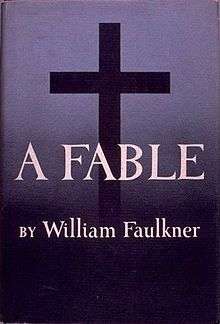A Fable
 First edition cover | |
| Author | William Faulkner |
|---|---|
| Cover artist | Riki Levinson[1] |
| Country | United States |
| Language | English |
| Published | 1954 (Random House) |
| Media type | Print (hardcover & paperback) |
| Preceded by | Requiem for a Nun |
| Followed by | The Town |
A Fable is a 1954 novel written by the American author William Faulkner. He spent more than a decade and tremendous effort on it, and aspired it to be "the best work of my life and maybe of my time".[2] It won the Pulitzer Prize[3] and the National Book Award,[4] but critical reviews were mixed and it is considered one of Faulkner's lesser works.[5] Historically, it can be seen as a precursor to Joseph Heller's Catch-22.
Synopsis
The book takes place in France during World War I and stretches through the course of one week in 1918. Corporal Stefan, who represents the reincarnation of Jesus, orders 3,000 troops to disobey orders to attack in the brutally repetitive trench warfare. In return, the Germans do not attack, and the war stops when soldiers realize that it takes two sides to fight a war. The Generalissimo, who represents leaders who use war to gain power, invites his German counterpart to discuss how to restart the war. He then arrests and executes Stephan. Before Stefan's execution, the Generalissimo tries to convince the corporal that war can never be stopped because it is the essence of human nature.
Following the execution of the Corporal, his body is returned to his wife and his sisters, and he is buried in Vienne-la-pucelle. However, after the conflict has resumed, the Corporal's grave is destroyed in a barrage of artillery. The spirit of the Corporal has transferred to a British message runner, who eventually confronts the old Generalissimo.
Critical analysis
In his contemporary review of A Fable, Philip Blair Rice noted that the novel returned Faulkner in subject matter to the one general subject that engaged him besides Mississippi, the First World War.[6] Dayton Kohler, in his contemporary analysis of the novel, discusses an approach to the novel through myth.[7] Ernest Sandeen has elaborated in detail on the parallels between the corporal and Jesus Christ.[8] Julian Smith has noted similarities between A Fable and Humphrey Cobb's novel Paths of Glory.[9] Frank Turaj has examined opposing images and themes in terms of the dialectic in the novel.[10] Thomas E Connolly has discussed the relationship of the three main plots of the novel to each other.[11]
Richard H. King has interpreted A Fable as the one major attempt by Faulkner to depict political action in his novels, and has characterised the novel as "Faulkner's failed political novel".[12] Robert W Hutten noted Faulkner's reworking of material originally from the story 'Notes on a Horse Thief' into A Fable.[13] William J Sowder has analysed in detail the character of the Generalissimo.[14]
Awards
References
- ↑ Modern first editions - a set on Flickr
- ↑ Blotner, Joseph, Faulkner: A Biography (one volume edition). University Press of Mississippi (Jackson, Mississippi, USA), ISBN 1-57806-732-4, p 576 (2005).
- 1 2 "Fiction". Past winners & finalists by category. The Pulitzer Prizes. Retrieved 2012-03-28.
- 1 2 "National Book Awards – 1955". National Book Foundation. Retrieved 2012-03-31. (With acceptance speech by Faulkner and essays by Neil Baldwin and Harold Augenbraum from the Awards 50- and 60-year anniversary publications.)
- ↑ "William Faulkner". The Mississippi Writers Page. Department of English. University of Mississippi. Retrieved 2012-03-31.
- ↑ Rice, Philip Blair (Autumn 1954). "Review: Faulkner's Crucifixion". The Kenyon Review. 16 (4): 661–664, 666–670. JSTOR 4333535.
- ↑ Kohler, Dayton (May 1955). "A Fable: The Novel as Myth". The English Journal. 44 (5): 253–260. JSTOR 809492.
- ↑ Sandeen, Ernest (January 1956). "William Faulkner: His Legend and His Fable". The Review of Politics. 18 (1): 47–68. JSTOR 1404940.
- ↑ Smith, Julian (November 1968). "A Source for Faulkner's A Fable". American Literature. 40 (3): 394–397. JSTOR 2923777.
- ↑ Turaj, Frank (Spring 1966). "The Dialectic in Faulkner's A Fable". Texas Studies in Literature and Language. 8 (1): 93–102. JSTOR 40753888.
- ↑ Connolly, Thomas E (July 1960). "The Three Plots of A Fable". Twentieth Century Literature. 6 (2): 70–75. JSTOR 440699.
- ↑ King, Richard H (Spring 1985). "A Fable: Faulkner's Political Novel?". The Southern Literary Journal. 17 (2): 3–17. JSTOR 20077762.
- ↑ Hutten, Robert W (May 1973). "A Major Revision in Faulkner's A Fable". American Literature. 45 (2): 297–299. JSTOR 2924456.
- ↑ Sowder, William J (Spring–Summer 1963). "Faulkner and Existentialism: A Note on the Generalissimo". Wisconsin Studies in Contemporary Literature. 4 (2): 163–171. JSTOR 1207153.
| Awards | ||
|---|---|---|
| Preceded by The Adventures of Augie March Saul Bellow |
National Book Award for Fiction 1955 |
Succeeded by Ten North Frederick John O'Hara |